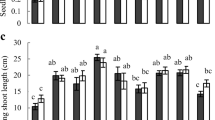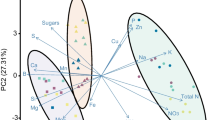Abstract
Hinoki-asunaro (Thujopsis dolabrata Sieb. et Zucc. var. hondai Makino) is a tree endemic in Japan whose seeds produce several terpenoids. We hypothesized that antifungal compounds in seeds might select for fungi on the root surfaces of T. dolabrata var. hondai seedlings. We examined seed and soil fungi, their sensitivity to methanol extracts of the seeds, the fungi on root surfaces of seedlings grown in Kanuma pumice (a model mineral soil) and nursery soil, and the frequency at which each fungus was detected on the seedling root surface. We calculated correlation coefficients between fungal detection frequency on root surfaces and fungal sensitivity to seed extracts. We also isolated from the seeds the antifungal compound totarol that selected for fungi on root surfaces. Species of Alternaria, Cladosporium, Pestalotiopsis, and Phomopsis were the most frequently isolated fungi from seeds. Mortierella and Mucor were the dominant fungi isolated from Kanuma pumice, whereas Umbelopsis and Trichoderma were the main fungi isolated from nursery soil. Alternaria, Cladosporium, Mortierella, Pestalotiopsis, and Phomopsis were the dominant fungi isolated from root surfaces of seedlings grown in Kanuma pumice, and Alternaria, Cladosporium, Pestalotiopsis, Phomopsis, and Trichoderma were the main root-surface fungi isolated from seedlings grown in nursery soil. The fungal detection frequencies on root surfaces in both soils were significantly and negatively correlated with fungal sensitivity to the seed extract. A similar correlation was found between the fungal detection frequency on root surfaces and fungal sensitivity to totarol. We conclude that totarol is one factor that selects for fungi on root surfaces of T. dolabrata var. hondai in the early growth stage.




Similar content being viewed by others
References
Ahn, Y. J., Lee, S. B., Lee, H. S., and Kim, G. H. 1998. Insecticidal and acaricidal activity of carvacrol and β-thujaplicine derived from Thujopsis dolabrata var. hondai sawdust. J. Chem. Ecol. 24:81–90.
Aoki, S. 1936. Nursing of hiba seedlings in Hokkaido. Hokkaido Ringyo Kaihou 34:8–16 (in Japanese).
Aomori Forestry Research Institute. 2004. Guide for Production Technique of Thujopsis dolabrata var. hondai Seedlings. Aomori Forestry Research Institute, Hiranai (in Japanese).
Barnett, H. L., and Hunter, B. B. 1998. Illustrated Genera of Imperfect Fungi. ARS Press, St.Paul.
Brimecombe, M. J., De Leij, F. A., and Lynch, J. M. 2001. The effect of root exudates on rhizosphere microbial populations, pp. 95–140, in R. Pinton, Z. Varanini, and P. Nannipieri (eds.). The Rhizosphere. Marcel Dekker Inc., New York.
Fujimori, S. 1958. Hiba seedlings and shading. Aomori For. Res. Inst. Kenkyu Dayori 98:1–2 (in Japanese).
Harley, J. L., and Waid, J. S. 1955. A method of studying active mycelia on living roots and other surfaces in the soil. Trans. Br. Mycol. Soc. 38:104–118.
Hasegawa, S., and Hirose, Y. 1980. A diterpene glycoside and lignans from seed of Thujopsis dolabrata. Phytochemistry 19:2479–2481.
Hasegawa, S., and Hirose, Y. 1982. Terpenoids from the seed of Thujopsis dolabrata var. dolabrata. Phytochemistry 21:643–646.
Homans, A. L., and Fuchs, A. 1970. Direct bioautography on thin-layer chromatograms as a method for detecting fungitoxic substances. J. Chromatogr. 51:327–329.
Inamori, Y., Sakagami, Y., Morita, Y., Shibata, M., Sugiura, M., Kumeda, Y., Okabe, T., Tsujibo, H., and Ishida, N. 2000. Antifungal activity of hinokitiol-related compounds on wood-rotting fungi and their insecticidal activities. Biol. Pharm. Bull. 23:995–997.
Ishimoto, H., Fukushi, Y., Yoshida, T., and Tahara, S. 2000. Rhizopus and Fusarium are selected as dominant fungal genera in rhizospheres of Brassicaceae. J. Chem. Ecol. 26:2387–2399.
Ito, K. 1974. Pathology of Forest Trees. Vol. III. Norin Shuppan Co., Ltd., Tokyo (in Japanese).
Itoya, Y. and Shimoda, N. 1995. Influence of soil-surface types and relative light intensity upon the germination of Thujopsis dolabrata var. hondai. For. Tree Breed. 175:12–14 (in Japanese, with English abstract).
Itoya, Y. and Shimoda, N. 1999. Lower nursery bed influences better growth of hiba seedlings: short-term nursing of hiba planting stocks. Forest Winds 2 (in Japanese).
Kobayashi, Y. and Asakawa, S. 1981. Thujopsis Sieb. et Zucc., pp. 118–121, in S. Asakawa, M. Katsuta, and T. Yokoyama (eds.). Seeds of Woody Plants in Japan, Gymnospermae. Japan Forest Tree Breeding Association, Tokyo (in Japanese).
Kusuma, I. W., Ogawa, T., Itoh, K., and Tachibana, S. 2004. Isolation and identification of an antifungal sesquiterpene alcohol from amboyna wood. J. Biol. Sci. (Pakistan) 7:1735–1740.
Lee, S. G., Kim, S. I., Ahn, Y. J., Kim, J. B., and Lee, B. Y. 1997. Effectiveness of carvacrol derived from Thujopsis dolabrata var. hondai sawdust against Thecodiplosis japonensis (Diptera: Cecidomyiidae). Pest. Sci. 49:119–124.
Miyazaki, Y. 1996. Effect of hiba (Thujopsis dolabrata var. hondai) wood oil on the house mite (Dermatophagoides pteronyssinus). Mokuzai Gakkaishi 42:624–626.
Mori, S., Yamaji, K., Ishimoto, H., Shimoda, N., Hitsuma, G., Kudoh, T., Itoya, Y., Narita, T., Hikage, M., and Takaki, N. 2003. Germination rate of hiba (Thujopsis dolabrata [L.f.] Sieb. & Zucc. var. hondai Makino) seeds and growth of the seedlings in two different soils. Tohoku J. For. Sci. 8:108–110 (in Japanese).
Morita, Y., Matsumura, E., Tsujibo, H., Yasuda, M., Sakagami, Y., Okabe, T., Ishida, N., and Inamori, Y. 2001. Biological activity of α-thujaplicin, the minor component of Thujopsis dolabrata Sieb. et Zucc. var. hondai Makino. Biol. Pharm. Bull. 24:607–611.
Morita, Y., Matsumura, E., Okabe, T., Fukui, T., Mitsunobu, S., Sugiura, M., Ohe, T., Tsujibo, H., Ishida, N., and Inamori, Y. 2004. Biological activity of α-thujaplicin, the isomer of hinokitiol. Biol. Pharm. Bull. 27:899–902.
Nagahama, S., Tajima, M., and Nishimura, K. 1996. Chemotaxonomy of ate (Thujopsis dolabrata) of Noto, Ishikawa Prefecture. Mokuzai Gakkaishi 42:698–702 (in Japanese, with English abstract).
Nakano, H. 2000. Raising of ate seedlings. For. Tree Breed. 195:6–12 (in Japanese, with English abstract).
O’donnell, K. 1993. Fusarium and its near relatives, pp. 225–233, in D. R. Reynolds and J. W. Taylor (eds.). The Fungal Holomorph: Mitotic, Meiotic and Pleiomorphic Speciation in Fungal Systematics. CAB International, Wallingford.
Okabe, T., Saito, K., Fukui, T., and Iinuma, K. 1994. Antibacterial activity of hinokitiol against methicillin-resistant Staphylococcus aureus (MRSA). Mokuzai Gakkaishi 40:1233–1238.
Raharivelomanana, P., and Bianchini, J.-P. 1995. Two-dimensional NMR of sesquiterpenes 8-coplete assignment of 1H and 13C NMR spectra of seven sesquiterpene alcohols from Necocallitropsis pancheri. Magn. Reson. Chem. 33:233–235.
Saito, K., Okabe, T., Fukui, T., and Inamori, Y. 1997. Antibacterial activity of hinokitiol against methicillin-resistant Staphylococcus aureus (MRSA). II. Application to the disinfections of hospital environments. Mokuzai Gakkaishi 43:882–891.
Sakurai, N., and Mori, M. 1985a. Germination of Thujopsis dolabrata var. hondai seeds and occurrence of the seedlings. Trans. Met. Tohoku Branch Jpn. For. Soc. 37:180–182 (in Japanese).
Sakurai, N., and Mori, M. 1985b. Prosperity and decline of Thujopsis dolabrata var. hondai seedlings under shading. Trans. Met. Tohoku Branch Jpn. For. Soc. 37:183–185 (in Japanese).
Solís, C., Becerra, J., Flores, C., Robledo, J., and Silva, M. 2004. Antibacterial and antifungal terpenes from Pilgerodendron uviferum (D. Don) Florin. Journal of the Chilean Chemical Society 49:157–161.
Takahashi, K., Yasue, M., Ogiyama, K., and Morimoti, S. 1981. The variation of diterpene in Thujopsis dolabrata var. hondai. Trans. Met. Tohoku Branch Jpn. For. Soc. 33:124–126 (in Japanese).
Warcup, J. H. 1950. The soil-plate method for isolation of fungi from soil. Nature 166:117–118.
Watanabe, T. 2002. Pictorial Atlas of Soil and Seed Fungi: Morphologies of Cultured Fungi and Key to Species. CRC Press, Boca Raton.
Waterman, P. G., and Mole, S. 1994. Analysis of Phenolic Plant Metabolites. Blackwell, London.
Werner, D. 2001. Organic signals between plants and microorganisms, pp. 197–222, in R. Pinton, Z. Varanini, and P. Nannipieri (eds.). The Rhizosphere. Marcel Dekker Inc., New York.
White, T. J., Bruns, T. D., Lee, S. B., and Taylor, J. W. 1990. Amplification and direct sequencing of fungal ribosomal RNA genes for phylogenetics, pp. 315–322, in M. A. Innis, D. H. Gelfand, J. J. Sninsky, and T. J. White (eds.). PCR Protocols: A Guide to Methods and Applications. Academic Press, San Diego.
Woodward, S., and Pearce, R. B. 1985. Methods for visualizing hyaline fungi for the detection of antifungal compounds on thin-layer chromatograms. Plant Pathol. 34:477–480.
Ying, B.-P., and Kubo, I. 1991. Complete 1H and 13C NMR assignments of totarol and its derivatives. Phytochemistry 30:1951–1955.
Acknowledgments
We thank the Hiranai Hiba Forestry Research Group for providing us with nursery soil; the Forestry Technology Center, Tohoku Regional Forest Office, for helping with the seed collection; and Mr. N. Shimoda for technical help with our work in the nursery. Financial support was provided in part by Research Fellowships of Japan Society for the Promotion of Science for Young Scientists and by a research grant of the Forestry and Forest Products Research Institute, Japan.
Author information
Authors and Affiliations
Corresponding author
Rights and permissions
About this article
Cite this article
Yamaji, K., Mori, S., Akiyama, M. et al. The Antifungal Compound Totarol of Thujopsis dolabrata var. hondai Seeds Selects for Fungi on Seedling Root Surfaces. J Chem Ecol 33, 2254–2265 (2007). https://doi.org/10.1007/s10886-007-9390-2
Received:
Revised:
Accepted:
Published:
Issue Date:
DOI: https://doi.org/10.1007/s10886-007-9390-2




